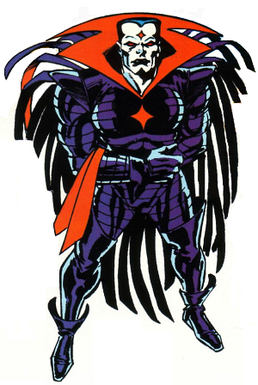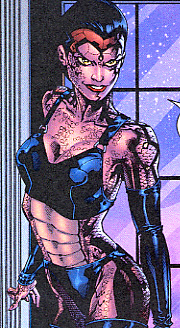
Professor X is a character appearing in American comic books published by Marvel Comics. Created by writer Stan Lee and artist/co-writer Jack Kirby, the character first appeared in The X-Men #1. The character is depicted as the founder and occasional leader of the X-Men.

Iceman is a superhero appearing in American comic books published by Marvel Comics and is a founding member of the X-Men. Created by writer Stan Lee and artist/co-plotter Jack Kirby, the character first appeared in The X-Men #1. Iceman is a mutant born with superhuman abilities. He has the ability to manipulate ice and cold by freezing water vapor around him. This allows him to freeze objects, as well as cover his body with ice.

The X-Men are a superhero team appearing in American comic books published by Marvel Comics. Created by writer/editer Stan Lee and artist/co-plotter Jack Kirby, the team first appeared in The X-Men #1. Although initially cancelled in 1970 due to low sales, following its 1975 revival and subsequent direction under writer Chris Claremont, it became one of Marvel's most recognizable and successful franchises. They have appeared in numerous books, television shows, 20th Century Studios's X-Men films, and video games. The X-Men title may refer to the superhero team itself, the eponymous comic series, or the broader franchise including various solo titles and team books such as the New Mutants, Excalibur, and X-Force.

Rogue is a character appearing in American comic books published by Marvel Comics, commonly in association with the X-Men. Created by Chris Claremont and Michael Golden, she first appeared in Avengers Annual #10 (1981). In her comic book appearances, Rogue is depicted as a mutant, a subspecies of humans born with an "X-gene" that grants superhuman abilities. She is capable of absorbing the life force, attributes, memories, and superpowers of anyone through physical touch. Rogue is initially portrayed as a reluctant supervillain, but she soon joins the X-Men as a superhero and has since endured as one of its most prominent members.

Colossus is a character appearing in American comic books published by Marvel Comics. Created by writer Len Wein and artist Dave Cockrum, he first appeared in Giant-Size X-Men #1.

Dr. Moira MacTaggert, more recently known as Moira X, is a fictional character appearing in American comic books published by Marvel Comics. She first appeared in The Uncanny X-Men #96 and was created by writer Chris Claremont and artist Dave Cockrum. She works as a geneticist and is an expert in mutant affairs. She is most commonly in association with the X-Men and has been a member of the Muir Island X-Men team and Excalibur.

Sabretooth is a fictional character appearing in American comic books published by Marvel Comics, commonly in association with the X-Men. Created by Chris Claremont and John Byrne, he first appeared in Iron Fist #14 and was initially depicted as a serial killer known as "the Slasher", before being developed into an X-Men villain during the "Mutant Massacre" crossover in 1986. This portrayal of Sabretooth has endured as the archenemy of the superhero Wolverine.

Magneto is a character appearing in American comic books published by Marvel Comics, commonly in association with the X-Men. Created by writer Stan Lee and artist/co-writer Jack Kirby, the character first appeared in The X-Men #1 as an adversary of the X-Men.

Apocalypse is a supervillain appearing in American comic books published by Marvel Comics. He is one of the world's first mutants, and was a principal villain for the original X-Factor team and later the X-Men and related spin-off teams. Created by writer Louise Simonson and artist Jackson Guice, Apocalypse first appeared in X-Factor #5. Apocalypse is one of the most powerful beings in the Marvel Universe where he is the husband of Genesis and the father of the original incarnation of the Horsemen of Apocalypse.
"Age of Apocalypse" is a 1995 comic book crossover storyline mostly published in the X-Men franchise of books by Marvel Comics. The Age of Apocalypse briefly replaced the universe of Earth-616 and had ramifications in the main Marvel Comics universe when the original timeline was restored. It was later retconned as having occurred in the alternate universe of Earth-295.

Mimic is a fictional character appearing in American comic books published by Marvel Comics. He was briefly a member of the X-Men in the 1960s, and was the first character to be added to the team after the original line-up and the first X-Man who was not a mutant.

Toad is a fictional character appearing in American comic books published by Marvel Comics. Created by writer Stan Lee and artist/co-writer Jack Kirby, he first appeared in The X-Men #4.

The Blob is a fictional character appearing in American comic books published by Marvel Comics. The character is usually depicted as an adversary of the X-Men. A mutant originally depicted as a morbidly obese circus freak, the Blob claims to be immovable when he so desires. He possesses an extreme amount of pliable body mass, which grants him superhuman strength. Possessing the demeanor of a bully, he mostly uses his powers for petty crime on his own, and as a member of the Brotherhood of Mutants and Freedom Force.

Mister Sinister is a supervillain appearing in American comic books published by Marvel Comics. Created by writer Chris Claremont, the character was first mentioned as the employer behind the team of assassins known as the Marauders in The Uncanny X-Men #212, and later seen in silhouette in The Uncanny X-Men #213, with both issues serving as chapters of the 1986 "Mutant Massacre" crossover. Mr. Sinister then made his first full appearance in The Uncanny X-Men #221. His appearance was designed by artist Marc Silvestri.

Onslaught is a character appearing in American comic books published by Marvel Comics. He first appeared as a cameo in X-Men: Prime #1 before making his first full appearance in X-Men vol. 2, #53, where he would eventually serve as the main antagonist of the “Onslaught” storyline from then onward.

Stacy X is a fictional character appearing in American comic books published by Marvel Comics. Created by writer Joe Casey and artist Tom Raney, she first appeared in Uncanny X-Men #399, when she was known as X-Stacy, and later became known as Ripcord. Stacy X belongs to the subspecies of humans called mutants, who are born with superhuman abilities. She was briefly affiliated with the X-Men and was later known as a member of the New Warriors.

The Marauders refers to one of two teams of fictional characters appearing in American comic books published by Marvel Comics. The original Marauders team included mutant warriors and assassins employed by the X-Men's enemy Mister Sinister, a mad scientist villain often intent on creating a perfect race of superhumans. At different times, the Marauders have been tasked by Sinister to perform kidnappings, assassinations, mass murder, or to simply fight Sinister's enemies. At different times, Marauders have been killed in combat, but often Mr. Sinister later uses his cloning technology to re-create them. This team of Marauders has appeared in many different stories of the X-Men franchise, as well as stories featuring other Marvel Comics heroes.
The Horsemen of Apocalypse are a team of supervillain characters appearing in American comic books published by Marvel Comics. Led by Apocalypse, they are loosely based on the Biblical Four Horsemen of the Apocalypse from the Book of Revelation, though its members vary throughout the canon.

Azazel is a supervillain appearing in American comic books published by Marvel Comics. Created by Chuck Austen and Sean Philips, the character first appeared in Uncanny X-Men #428. He belongs to the subspecies of humans named mutants, who are born with superhuman abilities. He is the father of the X-Men's Kiwi Black and was originally the father of Nightcrawler as well until that was retconned in 2023.















